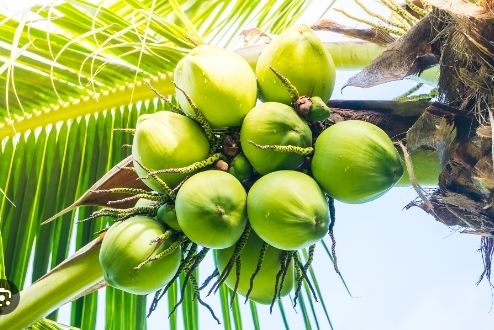Coconut exports in the world's Top 5: What does Vietnam need to do to maintain its position?
Thursday, July 24,2025
AsemconnectVietnam - Coconut brings Vietnam into the Top 5 largest exporting countries in the world. Removing bottlenecks will be a key for Vietnamese coconut industry to maintain its position and make a breakthrough in exports.
Coconut processing is still manual, leading to disadvantages in terms of cost and logistics
According to the report of Department of Cultivation and Plant Protection (Ministry of Agriculture and Environment), current coconut growing area in the country is about 202,000 hectares, harvested area is 181,000 hectares, the yield is 125.6 quintals/ha, output is 2.28 million tonnes. Coconuts and coconut products from Vietnam are exported to markets such as China, the United States, EU, Japan, Korea, Canada, etc.
Dr. Tran Minh Hai, Vice Principal of the School of Public Policy and Rural Development, said that large-scale coconut growing areas are now shifting to the Southeast and Central Highlands instead of being concentrated in Ben Tre, Tien Giang or Vinh Long as before. These areas currently have an area of 30-50 hectares, have been granted planting area codes, and can be ready to supply the export market.
However, there are differences between coconut varieties for drinking water and coconut for oil, if the right type and harvest time are not selected, coconut water can deteriorate during international transportation.
Sharing the same opinion on this issue, Ms. Nguyen Thi Kim Thanh, President of Vietnam Coconut Association, said that the Mekong Delta is the largest coconut growing area in the country thanks to favorable climate and soil conditions, with more than 20 coconut varieties cultivated in the form of household gardens.
However, due to habit of people arbitrarily introducing new varieties for planting without selection, it has led to cross-planting and cross-cultivation, reducing output quality. Only when there is specialized orientation from the authorities and the Association, the quality of coconuts has gradually stabilized. Meanwhile, the coconut processing industry is still manual, mostly peeled by hand for export, while many countries have applied modern production lines, leading to disadvantages in terms of cost and logistics.
For sustainable development, Vietnamese coconut industry needs a stable source of raw materials in terms of quality and output. Therefore, coordination between Ministry of Agriculture and Environment, institutes and schools is needed to come up with solutions to improve productivity and modernize production.
“We can process coconut in combination with other fruits such as bananas, pineapples, etc. to diversify products, thereby increasing value of Vietnamese fruits,” she shared, noting that building a digital map of coconut growing areas is urgent to affirm the value of coconut trees and serve traceability. In addition, it is necessary to promote coconut tree ecosystem through intercropping, taking advantage of water retention and soil improvement properties of coconut to increase ecological value and carbon credits.
Building a brand, limiting raw exports
According to Ms. Tran Le Hoa, Deputy Head of Social Sciences, Vietnam Coconut Association, managing growing areas using GIS technology is an inevitable step for Vietnamese coconut industry to transform towards transparency, professionalism and meet the increasingly high demands of international market.
Ms. Hoa emphasized that GIS application helps to accurately determine location of each coconut garden, area, density and number of trees grown through digital maps, thereby creating a complete and synchronous database to serve the issuance of planting area codes and traceability.
In particular, integrating planting area information with QR codes is a key tool to implement chain traceability, enhancing reliability of coconut products in the international market. This not only serves exports but also contributes to building the Vietnamese coconut brand on a transparent and sustainable basis.
However, Ms. Hoa noted that after organizing effective production, it is necessary to continue investing in communication. For farmers and cooperatives, it is necessary to promote digital communication and apply multimedia to introduce products to consumers. At the national level, a systematic communication strategy is needed, focusing on key export markets to create long-term competitive advantages.
Currently, there are 225 countries in the world with import demand, but up to now, only 179 countries have coconuts for export. Of these, 5-6 countries have an export output of over 90%, with Philippines, Indonesia, India, Sri Lanka, Vietnam and Malaysia leading the way.
By 2030, Vietnam aims to have a coconut growing area of about 195,000 -210,000 hectares, of which over 30% of coconut area is produced according to GAP and equivalent processes. Coconut area with a growing area code is about 30%.
MSc. Ngo Quoc Tuan, Deputy Director of Post-Import Plant Quarantine Center II, Department of Cultivation and Plant Protection (Ministry of Agriculture and Environment) commented that quality is not uniform, coconut industry is also facing strong competition from Thailand and Indonesia; traceability and limited GAP standards are 3 challenges for the coconut industry.
Market opportunity for coconuts is huge. However, prerequisite is to comply with traceability. Each enterprise, cooperative, and farmer household needs to become a transparent, quality, and safe link in the value chain.
To maintain its position and promote coconut exports, in the coming time, coconut industry needs to build a brand, invest in deep processing, build a sustainable chain of links to develop infrastructure for raw material areas. In addition, coconut industry also needs to implement solutions to limit the export of raw materials.
Source: Vitic/ congthuong.vn
According to the report of Department of Cultivation and Plant Protection (Ministry of Agriculture and Environment), current coconut growing area in the country is about 202,000 hectares, harvested area is 181,000 hectares, the yield is 125.6 quintals/ha, output is 2.28 million tonnes. Coconuts and coconut products from Vietnam are exported to markets such as China, the United States, EU, Japan, Korea, Canada, etc.
Dr. Tran Minh Hai, Vice Principal of the School of Public Policy and Rural Development, said that large-scale coconut growing areas are now shifting to the Southeast and Central Highlands instead of being concentrated in Ben Tre, Tien Giang or Vinh Long as before. These areas currently have an area of 30-50 hectares, have been granted planting area codes, and can be ready to supply the export market.
However, there are differences between coconut varieties for drinking water and coconut for oil, if the right type and harvest time are not selected, coconut water can deteriorate during international transportation.
Sharing the same opinion on this issue, Ms. Nguyen Thi Kim Thanh, President of Vietnam Coconut Association, said that the Mekong Delta is the largest coconut growing area in the country thanks to favorable climate and soil conditions, with more than 20 coconut varieties cultivated in the form of household gardens.
However, due to habit of people arbitrarily introducing new varieties for planting without selection, it has led to cross-planting and cross-cultivation, reducing output quality. Only when there is specialized orientation from the authorities and the Association, the quality of coconuts has gradually stabilized. Meanwhile, the coconut processing industry is still manual, mostly peeled by hand for export, while many countries have applied modern production lines, leading to disadvantages in terms of cost and logistics.
For sustainable development, Vietnamese coconut industry needs a stable source of raw materials in terms of quality and output. Therefore, coordination between Ministry of Agriculture and Environment, institutes and schools is needed to come up with solutions to improve productivity and modernize production.
“We can process coconut in combination with other fruits such as bananas, pineapples, etc. to diversify products, thereby increasing value of Vietnamese fruits,” she shared, noting that building a digital map of coconut growing areas is urgent to affirm the value of coconut trees and serve traceability. In addition, it is necessary to promote coconut tree ecosystem through intercropping, taking advantage of water retention and soil improvement properties of coconut to increase ecological value and carbon credits.
Building a brand, limiting raw exports
According to Ms. Tran Le Hoa, Deputy Head of Social Sciences, Vietnam Coconut Association, managing growing areas using GIS technology is an inevitable step for Vietnamese coconut industry to transform towards transparency, professionalism and meet the increasingly high demands of international market.
Ms. Hoa emphasized that GIS application helps to accurately determine location of each coconut garden, area, density and number of trees grown through digital maps, thereby creating a complete and synchronous database to serve the issuance of planting area codes and traceability.
In particular, integrating planting area information with QR codes is a key tool to implement chain traceability, enhancing reliability of coconut products in the international market. This not only serves exports but also contributes to building the Vietnamese coconut brand on a transparent and sustainable basis.
However, Ms. Hoa noted that after organizing effective production, it is necessary to continue investing in communication. For farmers and cooperatives, it is necessary to promote digital communication and apply multimedia to introduce products to consumers. At the national level, a systematic communication strategy is needed, focusing on key export markets to create long-term competitive advantages.
Currently, there are 225 countries in the world with import demand, but up to now, only 179 countries have coconuts for export. Of these, 5-6 countries have an export output of over 90%, with Philippines, Indonesia, India, Sri Lanka, Vietnam and Malaysia leading the way.
By 2030, Vietnam aims to have a coconut growing area of about 195,000 -210,000 hectares, of which over 30% of coconut area is produced according to GAP and equivalent processes. Coconut area with a growing area code is about 30%.
MSc. Ngo Quoc Tuan, Deputy Director of Post-Import Plant Quarantine Center II, Department of Cultivation and Plant Protection (Ministry of Agriculture and Environment) commented that quality is not uniform, coconut industry is also facing strong competition from Thailand and Indonesia; traceability and limited GAP standards are 3 challenges for the coconut industry.
Market opportunity for coconuts is huge. However, prerequisite is to comply with traceability. Each enterprise, cooperative, and farmer household needs to become a transparent, quality, and safe link in the value chain.
To maintain its position and promote coconut exports, in the coming time, coconut industry needs to build a brand, invest in deep processing, build a sustainable chain of links to develop infrastructure for raw material areas. In addition, coconut industry also needs to implement solutions to limit the export of raw materials.
Source: Vitic/ congthuong.vn
Cashew export prices jumped by nearly 24%
Leather and footwear exports grew by double digits
Daily: Domestic pepper prices down 500–2,000 VND/kg on July 23, 2025
Daily: Domestic rice prices rose slightly on July 23, 2025
Daily: Domestic coffee prices rose slightly on July 23, 2025
Fruit and vegetable exports are estimated to exceed 3.8 billion USD after 7 months, aiming for a target of 8 billion USD
Imports and exports approaches 500 billion USD mark
Spain, Algeria become new bright spots for Vietnamese coffee
Update on Vietnam’s fruit market situation as of mid-July 2025
Exports to Japan increased in first 6 months of 2025
Major commodity groups exported to South Korea in first 6 months of 2025
Vietnam - Singapore two-way trade in first 6 months of 2025
Chemical exports to Laos increased sharply in first half of 2025
Vietnamese pineapples 'at a good price' in Europe: Will billion-dollar dream come true?

Plan of Hai Duong province for a period of 2021 - 2030, ...
Organize space reasonably and harmoniously, focusing on connecting Hai Duong in common development space, actively contributing to the ...Plan of Hau Giang province in a period of 2021 - 2030, ...
Sustainable forestry development program in a period of ...

AI opens new path for image industry: Insiders
Though the term "image industry" remains relatively new in the local context, the development of a creative ecosystem driven by AI will ...Hanoi’s street food culture gains ground with Michelin nods
Draw held for 2025 Davis Cup Asia/Oceania Group III in Bac ...
Da Nang Museum opens an exhibition of rare ancient ...
An Giang races to complete UNESCO nomination dossier for ...



